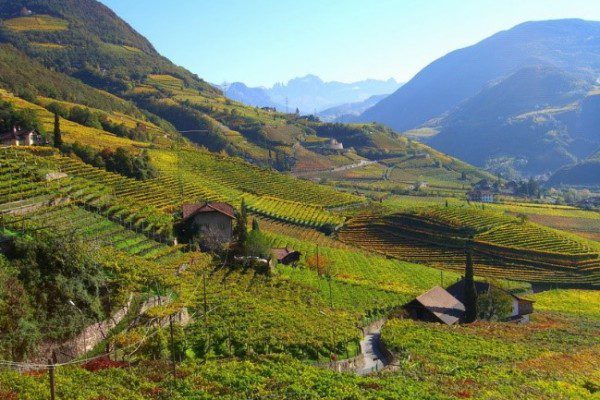Picture this…
You decide to step off the beaten path and organize a hiking trip to northern Italy. You watch as a dramatic landscape of rugged snow-capped peaks, contrasted against a bright lapis sky, slides past your rental car windows. The vibrant, emerald green valleys between the mountains are dotted here and there by clusters of sturdy Alpine houses built with characteristic white plaster walls and low, shingled roofs. A few of the houses are timbered and some bear proud boxes or hanging pots of colorful flowers. Vineyards and orchards blanket the lower rolling hills. The air here is fresh and clear, making all the colors seem almost unnaturally vivid and everything you see is bathed in the warm amber glow of the Mediterranean sun.
A winding road brings you into the small town of Luserna, where you’ve arranged to stay. Every street sign you pass appears to be in two languages, not one; Italian and . . . German? That’s a bit disorienting, but you’re ready for this. You’re in South Tyrol—or Alto Adige (or Südtirol, for the German speakers)—and knew well ahead of your trip that the region is formally bilingual and luckily, you speak German. You reach the inn you’ve reserved a room at and prepare to meet the smiling owner at the door, but as you reach your hand out, your ears are greeted by words that don’t seem to belong to either Italian or German. You blink, confused, and the innkeeper repeats his sentence more slowly. It sounds more or less Germanic, but also vaguely Italian, and try as you might, you just can’t make any of his meaning out. It’s an impossible tangle.
You’ve just stumbled upon Cimbrian, a little-known Germanic dialect spoken in a few remote parts of northeastern Italy and nowhere else on Earth. Cimbrian is most readily found scattered in isolated pockets across the region of Trentino, within what’s left of the communities of Luserna (Lusérn in Cimbrian), Sette Comuni (Siben Komoin), and Tredici Comuni (Dreizehn Komoin). It is unique among the other dialects and languages spoken in South Tyrol and differences in pronunciation, vocabulary, and grammar make it nearly unintelligible for speakers of modern standard German or Italian.
Most linguists now accept that Cimbrian most likely developed out of Southern Bavarian, but a wonderfully colorful variety of alternate theories has floated around over the ages. For a long time it was believed—or rather, hoped—that the language and its speakers were the surviving descendants of the early Germanic Langobards (Lombards), or Cimbri. For hundreds of years, the theory persisted that the Cimbrian communities are a surviving relic of an otherwise entirely dead early Germanic culture and language, as the name associated with the communities suggests.
The Cimbri—that’s the early Germanic tribe, not the present-day communities listed above—are thought to have originally come from Jutland, and, like many tribes at the time, mobilized against the Roman Republic between the years 113 and 101 BCE. The Cimbri were partially successful in their campaign, but were soundly defeated by the Roman general Gaius Marius when they attempted to invade northern Italy in 101 BCE. It seems likely that this is where the seed for the myth that the communities around Luserna are linked to early Germanic tribes was planted; in the fact that the tribes in question did press into northern Italy and were defeated and scattered there, albeit not in the immediate area of Luserna.
As exciting as it would be to be able to prove that the present-day Cimbrians are the surviving ancestors of the historical Cimbri or Langobards, it’s more likely that they’re descended from Bavarian settlers. Records from the mid-11th century suggest that a few families left the area around Benediktbeuern in Bavaria in search of fertile land and better living conditions during a time of famine. Most of the formal settlement of the area around Luserna occurred under the rule of Prince-Bishop Friedrich von Wangen around the early 13th century. The development of Tredici Comuni (a rough grouping of thirteen settlements) began around the mid-11th century, and that of Sette Comuni (also a grouping of settlements—this time seven of them) dates closer to the 13th and 14th centuries. Even though archaeological evidence suggests that portions of this area may have been inhabited as far back as the late Stone Age, nothing has ever been found to support the theory of an early Germanic link, and attempts to prove it from a linguistic angle have been, at their very best, inconclusive and unstable.
These early German (Bavarian) settlers to the area likely referred to themselves as “Zimbern,” from “Zimberer” as a reference to their skilled work with wood as carpenters, woodworkers, and lumberjacks (think “timberer”). This may have been misinterpreted as a reference to the “Zimbern” (Cimbri) of ancient history. Apart from various sorts of woodworking and wood-related products (like wood coal), the settlers also contributed to local agriculture through the raising and keeping of cows and sheep, as well as the production and sale of ice, dairy products, olives, wine, grain, and corn. Much of what these communities produced supported their own survival, but whatever surplus they had was sold or traded for things they couldn’t produce themselves.
The Cimbrian language itself is an unusual blend of Italian, a couple of different Bavarian dialects, and some very old forms of standard German glued together with its own unique vocabulary and pronunciation. Sadly, but perhaps unsurprisingly, Cimbrian is very much in danger of extinction, mostly from the increasing use of standard Italian in the region. The number of native Cimbrian speakers has declined dramatically from what it once was. Out of all the settlements that make up the Tredici Comuni, Sette Comuni, and Luserna, only Luserna is documented as still containing active native speakers. The village of Giazza (Ljetzan) is also recorded as still being home to a few native speakers, but they are aging and may no longer be present at all. Cimbrian has been officially recognized by provincial and national law and is under protection, though it’s uncertain how much good this will actually do in the long run. It is—or at least was—available as an elective class in the local school, but there are very few school-aged children remaining in Luserna.
At least parts of the remaining Cimbrian communities are protected as a natural reserve that’s meant to shield and preserve all the region’s treasures, both natural and cultural. The entirety of South Tyrol boasts a rich landscape of stunning natural wonders: caves, glacial lakes, spectacular mountain formations, rolling valleys that look like something straight out of a painting, and an endless supply of hiking and mountaineering opportunities. There are also fine vineyards, rich local cuisine, festivals, museums, castles, and exquisite gardens. Armed with this little bit of cultural knowledge and awareness, you are now better equipped to break free from the beaten path and engage the rich South Tyrolian landscape with somewhat enlightened eyes. Cimbrian is not the only ethnic subgroup to be found here. South Tyrol boasts a rich patchwork of unique cultural pockets. Get out there and meet them!
By Carrie Carlson








